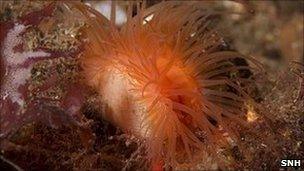Exploration around Ullapool confirms important species
- Published

A flame shell bed found within the Sruth Lagaidh Narrows in Loch Broom.
Exploration of the seas around Ullapool has helped confirm the presence of some of Scotland's important marine wildlife features.
The study was carried out by marine biologists from Heriot-Watt University's School of Life Sciences and Scottish Natural Heritage (SNH).
They charted the presence, condition and extent of a number of Priority Marine Features (PMFs)
This was a validation survey of the features of the Ullapool Approaches.
The scientists looked in Loch Broom, Little Loch Broom, Loch Gairloch, Loch Ewe, Gruinard Bay and the Summer Isles.
In Little Loch Broom a bed of the coral-like algae maerl was identified as one of the richest examples of the habitat in this part of Scotland.
Seagrass beds in Loch Gairloch and Gruinard Bay were more widespread than previously thought and scientists think the beds are possibly the richest examples in north Scottish waters.
Meanwhile, a diver survey authenticated the presence of a flame shell bed within the Sruth Lagaidh Narrows in Loch Broom.
'Greater understanding'
Colin Trigg, SNH's project manager for the Ullapool survey, said: "This work, carried out last year, represented the first of several planned marine explorations that will help us develop a greater understanding of the distribution and extent of species and habitats found in Scottish waters."
The work builds on previous surveys established by the British Geological Survey (BGS), which has shown that the present-day landscape of this region has been strongly shaped by Quaternary glaciation particularly over the past 500,000 years.
The submarine landscape of the Ullapool Approaches preserves excellent examples of glacially-scoured valleys and other erosional bedforms, formed by glaciers flowing towards The Minch.
Although previous records had suggested the presence of native oyster beds, horse mussel beds and the European spiny lobster, none were found.
However, the uncommon "tall sea pen" was found to be widespread, with high population densities present in the inner basins of Loch Broom and Little Loch Broom.